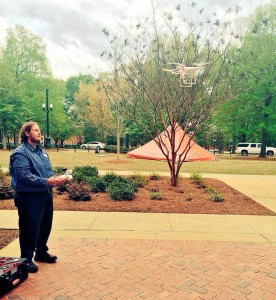By Larecca Rucker
Oxford Eagle Staff Writer
If you’re a tech geek or someone who is always first in line to acquire the latest innovative product that hits the market, chances are you’ve considered buying a drone.
R.J. Morgan, a journalism instructor and director of the Mississippi Scholastic Press Association, is the University of Mississippi’s “drone commander.” Thanks to a $3,000 donation by The Meek School of Journalism and New Media’s namesake, Ed Meek, the university purchased a drone for journalism experimentation, and Morgan is its pilot. He calls it “Farley,” named after the building that houses the journalism school.
Morgan demonstrated how the drone works last week during the Ole Miss New Media Conference Innovate 2015, and gave participants the opportunity to go outside and fly it themselves.
“These drones will go up to about 500 feet in the air, and you can get them about a half mile away from your person, although the current rules right now say the drone should always be in sight of the person who is using it,” he explained to an audience. “But they have pretty incredible range. We have been playing with this drone, which is one of the top models. It is fairly durable. I know because I have crashed it into a variety of settings. I’ve crashed it outdoors. I’ve crashed it indoors. And so far it has taken a licking, but it keeps on ticking.”
Morgan said an HD camera is attached to the drone, which produces a steady shot, even though the drone may be traveling at 30 miles per hour, stopping in one direction, and returning.
“You do not see that in the video,” he said. “The video remains incredibly stable, unless you are adjusting the camera.”
The drone can be connected to your smartphone and operated using an app. Morgan logs into a network and connects to the drone.
“I have on my smartphone exactly what the drone is seeing,” he said.
Drone operators with this model don’t have to worry about losing their drone if they become disconnected. Using a GPS sensor, the drone locks its ground coordinates into place before it takes off.
“It records the GPS coordinates of the piece of ground you are sitting on,” Morgan said, “and then, if at any point during flight it loses connection with the control, … it will return automatically to the space it took off from.”
Morgan said a sensor on the operating screen tells him the elevation of the drone.
“If I elevate it to 200 feet and let go of the joy stick, it will move around a little bit because of the wind, but it will pretty much hover in that exact spot at 200 feet until I tell it to do otherwise,” he said.
The drone has a short battery life. You can only film about 15-20 minutes before the battery dies.
“So you’re talking about a real short amount of time to get to where you’re going before you can film,” Morgan said.
Using your smartphone screen, you can view exactly what the drone is recording. You have the option of taking a still shot or a video. The photos and footage are stored on a micro SD card in the drone as MP4 files.
Journalists, photographers and tech geeks who have made the purchase are finding a variety of interesting ways to use drones, including capturing brilliant fireworks displays; shooting aerial views of fires, traffic, weather and other news events; photographing and filming concerts and festivals; and using drones to shoot real estate photographs.
“There are a few legal restrictions that we are still working out the kinks with,” said Morgan, who noted drone uses are still being explored.
High school purchases
Several high schools have purchased drones, including Pearl, Tupelo, New Albany and Jackson Prep. Morgan said they use it to cover football games on Friday nights.
“I believe it was Pearl who said the first couple of times they flew the drone during football games, it was a competitive advantage,” Morgan said. “They had been flying it to get football practice shots, so all of their players were used to seeing the things, but the other team couldn’t help but keep looking up, and so they were distracted.”
Debora Wenger, associate professor of journalism at the University of Mississippi, said there are challenges with drones. The Federal Aviation Administration regulates drone use.
“Their preference is that you have a commercial pilot’s license in order to use one of these for any kind of commercial purposes,” Wenger said, adding that the use of drones also raises ethical concerns about privacy. “It certainly has its challenges right now, but as journalists or marketers, we need to be talking about how this technology may affect our jobs and our careers.”
Hank Price, the owner of a Birmingham, Alabama, television station, was a presenter at the conference. During the session, he talked about how FAA drone regulations have affected business.
Commercial use
“We are not allowed, as a news organization, to shoot with drones right now,” he said, “and we would be in a lot of trouble if we did. But if (the footage) comes to us from somebody else, and it’s newsworthy, we can use that. If one of our employees owns a drone (as a private citizen) and they happen to get news footage, we can use that. … But if they are shooting something commercial, we can’t use it. It’s crazy, but it’s the law.”
Price believes the law should be amended. He said it would save television stations a lot of money that they would have otherwise spent to purchase or rent helicopters for aerial shots.
“When you think about it, helicopters are going to run at a minimum of $450 an hour, more like $750,” he said. “… If you’re going to get a helicopter, the camera and pedestal mounts are about $600,000. The helicopter is $1.5 or $2 million.”
You also have to pay a pilot, and Price said insurance costs around $30,000.
“You compare all of this to a drone, even if you were going to pay $10,000 so that it could do everything,” he said. “So this has to be solved.”
Wenger also talked about wearables during the conference. The Apple watch released last week is one example of a new line of tech products that may change or impact society.
“Wearables are the second type of communications technology that’s going to affect your lives, and certainly our lives as educators,” she said.
Published April 13, 2015, by The Oxford Eagle. Posted with permission.

